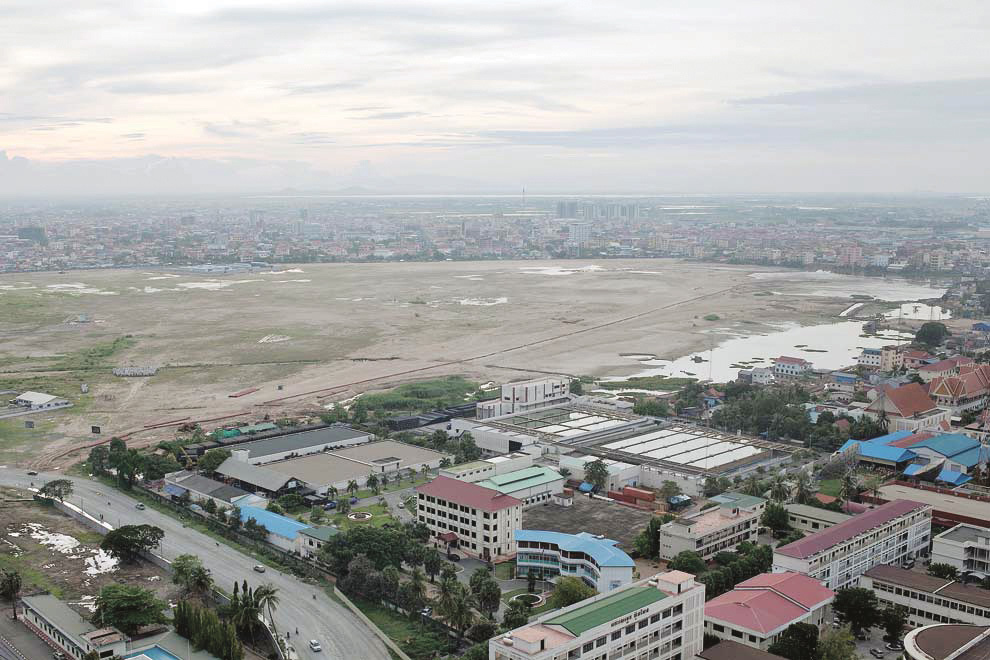បារាំង និងអឺរ៉ុប ប្តេជ្ញាជួយពង្រឹងវិស័យទឹកស្អាតនៅកម្ពុជា, ខណៈបារាំងគ្រោងផ្តល់ហិរញ្ញប្បទាន ២៧៥លានអឺរ៉ូ
ប្រទេសបារាំង និងសហភាពអឺរ៉ុបបានអះអាងជាថ្មីពីការយកចិត្តទុកដាក់ក្នុងការគាំទ្រដល់ការអភិវឌ្ឍវិស័យទឹកនៅកម្ពុជា ដោយប្រទេសបារាំងគ្រោងនឹងហិរញ្ញប្បទានប្រមាណ ២៧៥លានអឺរ៉ូ សម្រាប់ឆ្នាំ២០២៥ ដល់ ឆ្នាំ២០២៧។ ការប្តេជ្ញាចិត្តនេះត្រូវបានប្រកាសដោយលោកស្រី Sandrine Boucher នាយកប្រចាំប្រទេសនៃទីភ្នាក់ងារអភិវឌ្ឍន៍បារាំង (AFD) ក្នុងជំនួបជាមួយហែម វណ្ណឌី រដ្ឋមន្ត្រីក្រសួងឧស្សាហកម្ម វិទ្យាសាស្ត្រ បច្ចេកវិទ្យា និងនវានុវត្តន៍ នៅថ្ងៃទី៥ ខែមិថុនា ឆ្នាំ២០២៥។ ក្នុងកិច្ចពិភាក្សានោះ លោកស្រី Boucher បានគូសបញ្ជាក់ថា ថវិកាប្រមាណ ៧០% សម្រាប់ការអភិវឌ្ឍក្នុងវិស័យទឹកស្អាត។ ក្នុងកិច្ចខិតខំប្រឹងប្រែងដើម្បីផ្តល់អំណាចដល់វិស័យឯកជន AFD កំពុងសហការជាមួយធនាគារពាណិជ្ជដើម្បីបង្កើតកញ្ចប់ឥណទានថ្មីតាមរយៈ PROPARCO ក្នុងគោលបំណងផ្តល់ការគាំទ្រផ្នែកហិរញ្ញវត្ថុដល់ប្រតិបត្តិករទឹកឯកជន។ គំនិតផ្តួចផ្តើមនេះមានសារៈសំខាន់ណាស់ ដោយសារប្រតិបត្តិករទាំងនេះដើរតួនាទីសំខាន់ក្នុងការផ្តល់សេវាទឹកស្អាតដល់សហគមន៍ជនបទ។ ក្នុងនោះដែរ ឯកឧត្តម ហែម វណ្ណឌី បានណែនាំឱ្យក្រុមការងារបច្ចេកទេសរបស់ក្រសួង សហការជាមួយក្រុមហ៊ុន PROPARCO ដែលជាដៃគូបម្រើវិស័យឯកជនរបស់ AFD ដើម្បីសម្រួលការផ្តល់ហិរញ្ញប្បទានក្នុងអត្រាការប្រាក់សមរម្យសម្រាប់ប្រតិបត្តិករទឹកស្អាតឯកជន ដោយសារប្រតិបត្តិករទាំងនេះដើរតួនាទីយ៉ាងសំខាន់ក្នុងការផ្តល់សេវាទឹកស្អាតដល់ប្រជាជនក្នុងតំបន់ជនបទ។ លើសពីនេះ តំណាងមកពីសហភាពអឺរ៉ុបបានសម្តែងការគាំទ្រយ៉ាងខ្លាំងរបស់ពួកគេចំពោះកំណែទម្រង់ចាំបាច់នៅក្នុងវិស័យទឹករបស់កម្ពុជាផងដែរ។ លោក Koen Everaert អនុប្រធានកិច្ចសហប្រតិបត្តិការនៃគណៈប្រតិភូសហភាពអឺរ៉ុបប្រចាំនៅកម្ពុជា បានរំលឹកឡើងវិញថា ទឹក ថាមពល […]
ត្រឹមឆ្នាំ២០២៤ វិស័យកសិកម្មនៅកម្ពុជាបានរួមចំណែកជិត១៧% នៃGDP បើគិតជាទឹកប្រាក់ $៧,៨២ពាន់លាន
គិតត្រឹមឆ្នាំ២០២៤ វិស័យកសិកម្មនៅកម្ពុជាបានរួមចំណែកប្រមាណ ១៦,៧%ក្នុងផលិតផលសរុបក្នុងស្រុក ហើយតម្លៃបន្ថែមសរុបនៃវិស័យកសិកម្ម (Gross Value Added in Agriculture) នឹងបន្តកើនឡើងក្នុងទំហំទឹកប្រាក់ ៧,៨២ពាន់លានដុល្លារ។ នេះបើយោងតាមសេចក្ដីប្រកាសព័ត៌មានស្ដីពីលទ្ធផលនៃកិច្ចប្រជុំសមាជរដ្ឋសភា និងព្រឹទ្ធសភា លើវិស័យកសិកម្ម នៅថ្ងៃទី៤ ខែឧសភា ឆ្នាំ២០២៥។ សេចក្តីប្រកាសដដែលបានឱ្យដឹងថា គិតត្រឹមឆ្នាំ២០២៤ វិស័យកសិកម្មបានរួមចំណែកប្រមាណ ១៦,៧%ក្នុងផលិតផលសរុបក្នុងស្រុក ហើយតម្លៃបន្ថែមសរុបនៃវិស័យកសិកម្ម (Gross Value Added in Agriculture) បន្តកើនឡើងជារៀងរាល់ឆ្នាំ ពី ១៩.៨០៥ ពាន់លានរៀល (ប្រមាណ ៤,៩៥ ពាន់លានដុល្លារ) នៅឆ្នាំ២០១៥ ដល់ ២៤.២៨២ ពាន់លានរៀល (ប្រមាណ ៦,០៧ពាន់លានដុល្លារ) នៅឆ្នាំ ២០២០ និងដល់ ៣១.២៩២ ពាន់លានរៀល (ប្រមាណ ៧,៨២ពាន់លានដុល្លារ) នៅឆ្នាំ២០២៤។ ដោយឡែក ការចូលរួមចំណែករបស់អនុវិស័យនានាក្នុងវិស័យកសិកម្ម រួមមាន៖ផ្នែកដំណាំ ៦១,៣% ផ្នែកផលិតកម្មសត្វ ១៥,៤% ផ្នែកជលផល […]
គម្រោងពង្រីកផ្លូវជាតិលេខ៧(ពីរង្វង់មូលស្គន់ ដល់ គល់ស្ពានគីហ្សូណា) សម្រេចបាន ៥៦%
គម្រោងពង្រីក និងលើកកម្រិតគុណភាពផ្លូវជាតិលេខ៧ ទៅជា៤គន្លង (ពីរង្វង់មូលស្គន់-គល់ស្ពានគីហ្សូណា) សម្រេចបាន ៥៦% ហើយ។ នេះបើតាមការលើកឡើងរបស់ឯកឧត្តម អ៊ុន ចាន់ដា អភិបាល នៃគណៈអភិបាលខេត្តកំពង់ចាម នៅក្នុងកិច្ចប្រជុំរបស់ក្រុមប្រឹក្សាខេត្ត នៅថ្ងៃទី១០ ខែមិថុនា ឆ្នាំ២០២៥។ ឯកឧត្តមអភិបាល បានបញ្ជាក់ថា ជាការវាយតម្លៃជារួមសម្រាប់គម្រោងពង្រីកផ្លូវជាតិលេខ៧ គិតចាប់ពី រង្វង់មូលស្គន់ ស្រុកជើងព្រៃ រហូតដល់រង្វង់មូលគល់ស្ពានគីហ្សូណាក្រុងកំពង់ចាម គឺសម្រេចបាន ៥៦% នៃផែនការរួម ក្នុងនោះរួមមាន៖ ១. ការងារសាងសង់ផ្លូវ ប្រវែងសរុប ៤៥.៥គីឡូម៉ែត្រ សម្រេចបាន ៦០.២៥% ២.ការងារសាងសង់ស្ពាន សរុបចំនួន ០៨កន្លែង សម្រេចបាន ៩៤.៧៥% ៣.ការងារលូទទឹងផ្លូវ សម្រេចបាន ៥០កន្លែង ស្មើនឹង ៩៦.១៥% ៤.ធ្វើប្រឡាយថ្មអក្សរT សម្រេចបាន ៥៦០ម៉ែត្រ ស្មើនឹង ១៥.៩៥% ៥.លូជ្រុង សម្រេចបាន ១២,៩៤១ម៉ែត្រ ស្មើនឹង ៤៦.៧២% ៦.ការងារបើកទ្រូងផ្លូវ សរុបចំនួន […]
អាជ្ញាធរខេត្តហឺណានរបស់ចិន ចង់វិនិយោគលើវិស័យកសិ-ឧស្សាហកម្មកែច្នៃនៅកម្ពុជា
អាជ្ញាធរខេត្តដ៏ធំមួយរបស់ប្រទេសចិន គឺខេត្តហឺណាន ដែលមានប្រជាជនរហូតដល់ជាង ១០០លាននាក់ និងមានសក្តានុពលទីផ្សារពាណិជ្ជកម្មខ្លាំង បានបង្ហាញពីចេតនាចង់វិនិយោគលើវិស័យកសិ-ឧស្សាហកម្មកែច្នៃនៅកម្ពុជា។ នេះបើយោងតាមជំនួបពិភាក្សារវាងឯកឧត្តម លីម ឡោកពិសិដ្ឋ រដ្ឋលេខាធិការក្រសួងពាណិជ្ជកម្ម ជាមួយលោក SUN Shougang អភិបាលរងខេត្តហឺណាន ប្រទេសចិន នៅថ្ងៃទី២៨ ខែឧសភា ឆ្នាំ២០២៥។ ក្នុងជំនួបនេះ ភាគីទាំងពីរបានពិភាក្សាទៅលើការពង្រឹងកិច្ចសហប្រតិបត្តិការទ្វេភាគី ដោយផ្តោតសំខាន់ទៅលើកិច្ចសហប្រតិបត្តិការពាណិជ្ជកម្ម និងកសិ-ឧស្សាហកម្ម។ នាឱកាសនោះ លោកអភិបាលរងខេត្តហឺណាន បានវាយតម្លៃខ្ពស់ចំពោះសារៈសំខាន់នៃការពង្រឹងទំនាក់ទំនងនេះ ដោយបានអនុញ្ញាតឱ្យមន្ទីពាណិជ្ជកម្មខេត្តហឺណានដឹកនាំប្រតិភូទៅស្វែងរកឱកាសធ្វើពាណិជ្ជកម្ម និងវិនិយោគលើវិស័យកសិ-ឧស្សាហកម្មកែច្នៃនៅកម្ពុជានៅក្នុងឆ្នាំនេះផងដែរ។ ជាមួយគ្នានេះដែរ ឯកឧត្តមរដ្ឋលេខាធិការក្រសួងពាណិជ្ជកម្ម ក៏បានលើកទឹកចិត្តឱ្យក្រុមហ៊ុនចិនពង្រីកទំហំនាំចូលផលិតផលសំខាន់ៗរបស់កម្ពុជាដូចជា៖ ស្វាយចន្ទី ដំណាប់ស្វាយ និងចេក ព្រមទាំងពិចារណាក្នុងការវិនិយោគដោយផ្ទាល់លើវិស័យកសិ-ឧស្សាហកម្មកែច្នៃ ដើម្បីគាំទ្រផលិតកម្មដែលមានតម្លៃបន្ថែម។ បន្ទាប់ពីជំនួបពិភាក្សានេះរួច ប្រតិភូក្រសួងពាណិជ្ជកម្ម ក៏បានជួបពិភាក្សាជាមួយនឹង លោកស្រី CHEN Xuemei ប្រធានក្រុមហ៊ុន Chen Sun Fruits and Vegetable Trading Co., Ltd. ដែលជាក្រុមហ៊ុនបោះដុំផ្លែឈើ និងទំនិញកសិផលដ៏ធំនៃខេត្តហឺណាន ខណៈកន្លងមកក្រុមហ៊ុននេះក៏បាននាំចូលផ្លែឈើ និងផលិតផលកសិផលពីកម្ពុជាជាច្រើនសម្រាប់ចែកចាយទៅកាន់ទីផ្សារនៃខេត្តហឺណានផងដែរ។ គួររម្លឹកថា […]
ក្រសួងការងារកម្ពុជា និងមូលនិធិការងារអន្តរជាតិជប៉ុន រួមគ្នាពង្រឹងគាំទ្រអ្នកសេដ្ឋកិច្ចក្រៅប្រព័ន្ធ
ក្រសួងការងារ និងបណ្ដុះបណ្ដាលវិជ្ជាជីវៈរបស់កម្ពុជា រួមជាមួយមូលនិធិការងារអន្តរជាតិជប៉ុន (JILAF) បានចុះហត្ថលេខាលើអនុស្សរណៈនៃការយោគយល់គ្នា ដើម្បីពង្រឹងកិច្ចសហប្រតិបត្តិការក្រោមគម្រោងគាំទ្រសកម្មភាពថ្នាក់មូលដ្ឋាន តាមរយៈបណ្ដាញនិយោជក និងកម្មករនិយោជិតអន្ដរជាតិ។ អនុស្សរណៈនេះ ត្រូវបានចុះនៅថ្ងៃទី២៦ ខែឧសភា ឆ្នាំ២០២៥ នៅទីក្រុងតូក្យូ ប្រទេសជប៉ុន ក្នុងគោលបំណងជំរុញការងារសមរម្យ និងការធ្វើឱ្យកាន់តែប្រសើរឡើងនូវជីវភាពរបស់អ្នកធ្វើការនៅក្នុងសេដ្ឋកិច្ចក្រៅប្រព័ន្ធនៅកម្ពុជា តាមរយៈការបណ្តុះបណ្ដាលវិជ្ជាជីវៈ ការរៀបចំសិក្ខាសាលាស្ដីពីការគ្រប់គ្រងហិរញ្ញវត្ថុ និងប្រព័ន្ធគាំពារសង្គមនៅកម្ពុជា។ បន្ថែមពីនេះ អនុស្សរណៈនេះ ជាការសន្យារបស់មូលនិធិការងារអន្តរជាតិជប៉ុន និងថ្នាក់ដឹកនាំក្រសួងសុខាភិបាល ការងារ និងសុខុមាលភាពជប៉ុន និងការិយាល័យអង្គការអន្ដរជាតិខាងការងារប្រចាំប្រទេសជប៉ុន ក្នុងការពង្រឹងកិច្ចសហប្រតិបត្តិការជាមួយក្រសួងការងារ និងបណ្ដុះបណ្ដាលវិជ្ជាជីវៈរបស់កម្ពុជា ឱ្យកាន់តែស៊ីជម្រៅបន្ថែមទៀត។ ផ្អែកតាមអនុស្សរណៈនេះ វាជាការលើកកម្ពស់ជីវភាពរស់នៅរបស់អ្នកធ្វើការនៅក្នុងសេដ្ឋកិច្ចក្រៅប្រព័ន្ធ ដែលរួមមានជាអាទិ៍៖ អ្នកបម្រើការងារក្នុងសហគ្រាសធុនមីក្រូ តូច និងមធ្យម ដែលមិនបានចុះបញ្ជីការផ្លូវការ, អ្នកបម្រើក្នុងផ្ទះ, បុគ្គលស្វ័យនិយោជន៍ ដូចជា អ្នកបើកបររ៉ឺម៉កកង់បី (តុកតុក), អាជីវករលក់ដូរតាមផ្លូវ, កសិករខ្នាតតូច, អ្នកធ្វើការដោយប្រើថ្នាលបច្ចេកវិទ្យា និងបុគ្គលដទៃទៀតដែលបំពេញការងារដោយគ្មានកិច្ចសន្យាការងារផ្លូវការ គ្មានប្រាក់ចំណូលច្បាស់លាស់ ឬពុំទាន់ទទួលបានអត្ថប្រយោជន៍របបសន្ដិសុខសង្គមជាមូលដ្ឋាន។ បើតាម ឯកឧត្ដម ហេង សួរ បានឱ្យដឹងក្នុងពិធីចុះហត្ថលេខាខាងលើនេះថា មូលនិធិការងារអន្តរជាតិជប៉ុន (JILAF) បានសហការជាយ៉ាងជិតស្និទ្ធជាមួយក្រសួងការងារ […]
ស្ពានអាកាសភ្លោះភ្ជាប់ព្រំប្រទល់រវាងរាជធានីភ្នំពេញ និងខេត្តកណ្តាល សង់បាន ៨៥%
គិតមកដល់ពេលនេះ ការដ្ឋានសាងសង់ស្ពានអាកាសសម្តេចធិបតី ហ៊ុន ម៉ាណែត ស្ថិតនៅតាមបណ្ដោយមហាវិថីសម្ដេចតេជោ ហ៊ុន សែន ប្រសព្វ និងផ្លូវជាតិលេខ២ ដែលជាព្រំប្រទល់រវាង រាជធានីភ្នំពេញ និងខេត្តកណ្តាល សម្រេចបាន ៨៥ភាគរយហើយ ខណៈស្ពានអាកាសភ្លោះថ្មីនេះ ក៏បានឈានដល់ដំណាក់កាលតភ្ជាប់តួស្ពានរួចរាល់ហើយផងដែរ។ ពិធីនេះតភ្ជាប់តួស្ពាននេះ ត្រូវបានធ្វើឡើងនៅថ្ងៃទី៩ ខែមិថុនា២០២៥នេះ ក្រោមអធិបតីភាពឯកឧត្ដម ឃួង ស្រេង អភិបាលរាជធានីភ្នំពេញ និងពីមន្ត្រីពាក់ព័ន្ធជាច្រើនរូបទៀត។ លោក សាំ ពិសិដ្ឋ ប្រធានមន្ទីរសាធារណការ និងដឹកជញ្ជូនរាជធានីភ្នំពេញ បានឱ្យដឹងថា៖ ពេលនេះស្ពានអាកាសសម្តេចធិបតី ហ៊ុន ម៉ាណែត ទាំងមូលសម្រេចបានប្រមាណ ៨៥ភាគរយហើយ ក្នុងនោះស្ពានអាកាសដែលមានទិសដៅពីភ្នំពេញ ទៅអាកាសយានដ្ឋានអន្តរជាតិតេជោខេត្តកណ្តាល នឹងរួចរាល់នៅចុងខែមិថុនានេះ។ ចំណែកស្ពានអាកាសដែលមានទិសដៅពីអាកាសយានដ្ឋានអន្តរជាតិតេជោមកភ្នំពេញវិញនឹងរួចរាល់នៅចុងខែកក្កដាឆ្នាំ២០២៥ខាងមុខ។ សូមជម្រាប់ថា ស្ពានអាកាសភ្លោះនេះ ជាប្រភេទស្ពានបេតុងអាមេ ( ធ្នឹមរាងអក្សរ I )មានបណ្ដោយ ស្ពាន៦២២ម៉ែត្រ ក្នុងនោះស្ពានទី១: ផ្លូវឯកទិសមានទិសដៅតាមបណ្តោយមហាវិថីសម្តេចតេជោ ហ៊ុន សែន ឆ្លងកាត់ផ្លូវជាតិលេខ២ឆ្ពោះទៅកាន់អាកាសយានដ្ឋានអន្តរជាតិតេជោ។ ស្ពានទី២: ផ្លូវឯកទិសមានទិសដៅឆ្លងកាត់ផ្លូវជាតិលេខ២ពីអាកាសយានដ្ឋានអន្តរជាតិតេជោ […]



 English
English







